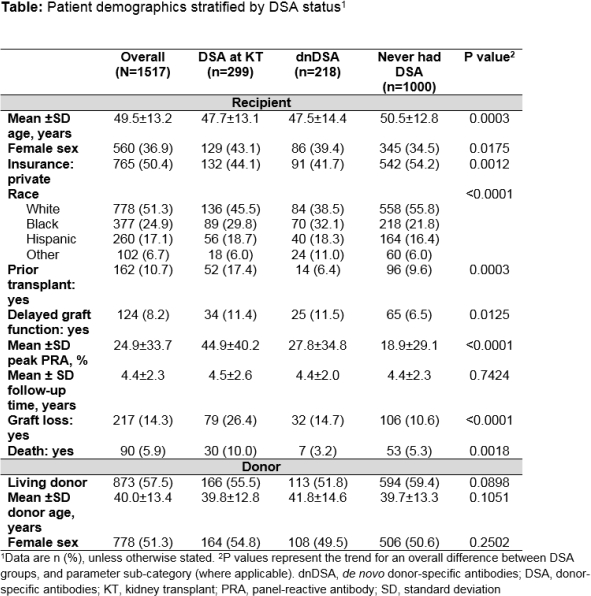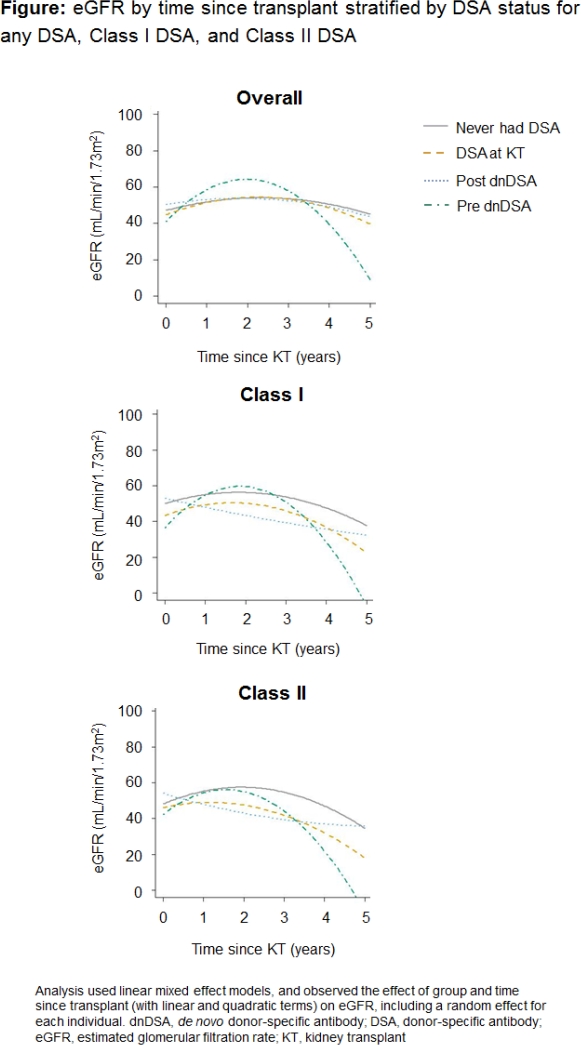Change in Estimated Glomerular Filtration Rate Pre and Post Development of Donor-Specific Antibodies after Kidney Transplantation
1Northwestern University Transplant and Outcomes Research Collaborative (NUTORC), Chicago
2Dept of Preventive Medicine, Northwestern University, Chicago
3Astellas Pharma Global Development, Inc., Northbrook.
Meeting: 2018 American Transplant Congress
Abstract number: D84
Keywords: Glomerular filtration rate (GFR), HLA antibodies, Kidney transplantation, Renal function
Session Information
Session Name: Poster Session D: Kidney Complications: Late Graft Failure
Session Type: Poster Session
Date: Tuesday, June 5, 2018
Session Time: 6:00pm-7:00pm
 Presentation Time: 6:00pm-7:00pm
Presentation Time: 6:00pm-7:00pm
Location: Hall 4EF
Formation of de novo donor-specific antibodies (dnDSA) against human leukocyte antigens contributes to inferior kidney transplant (KT) outcomes. We assessed the effect of dnDSA on estimated glomerular filtration rate (eGFR) in the largest single-center KT cohort to date.
Demographic, graft, and patient data were collected for all adult KT recipients (KTRs) in the Northwestern Medicine transplant center (2007–2015). DSA was assessed at KT (time 0), 3 and 6 months, 1 and 2 years, and for cause. Patient groups were: never had DSA, dnDSA, and DSA at KT. Kidney allograft function was assessed by eGFR from 1 month post KT using the Modification of Diet in Renal Disease 4 equation with calculation of the annual mean rate of eGFR change. eGFR over time was examined via linear mixed effect models.
Overall, 1517 KTRs (mean ±standard deviation age 49.5±13.2 yrs, 36.9% female) were followed for ≤8 yrs (mean 4.4 yrs). Patient demographics are presented in the Table. Mean estimated annual rate of eGFR change (mL/min/1.73m2) was 0.01 overall and −0.02 for DSA at KT. Mean estimated annual rate of eGFR change (mL/min/1.73m2) was 0.08 vs −0.06 pre- and post-dnDSA development, respectively (class I: 0.08 vs −0.08; class II: 0.03 vs −0.08) (Figure).
Renal function improved post KT, prior to the development of dnDSA, and worsened afterwards, at a rate greater than DSA at KT. Multivariable analysis, however, was not attempted due to the large baseline differences between groups and insufficient sample size to adjust for all covariates. However, minimizing DSA formation may help preserve long-term allograft function in KTRs.
CITATION INFORMATION: Ho B., Montag S., Bhagat H., Atiemo K., Daud A., Kang R., Zhao L., Schwartz J., Ladner D. Change in Estimated Glomerular Filtration Rate Pre and Post Development of Donor-Specific Antibodies after Kidney Transplantation Am J Transplant. 2017;17 (suppl 3).
To cite this abstract in AMA style:
Ho B, Montag S, Bhagat H, Atiemo K, Daud A, Kang R, Zhao L, Schwartz J, Ladner D. Change in Estimated Glomerular Filtration Rate Pre and Post Development of Donor-Specific Antibodies after Kidney Transplantation [abstract]. https://atcmeetingabstracts.com/abstract/change-in-estimated-glomerular-filtration-rate-pre-and-post-development-of-donor-specific-antibodies-after-kidney-transplantation/. Accessed January 7, 2026.« Back to 2018 American Transplant Congress


